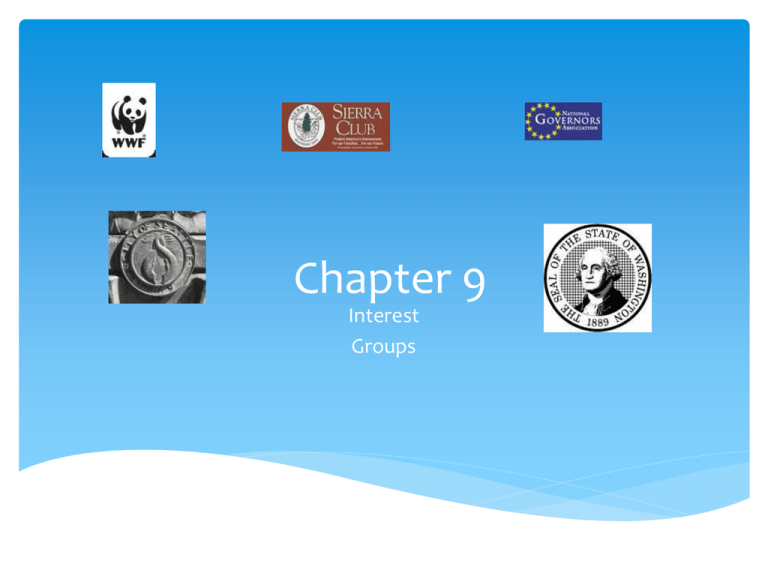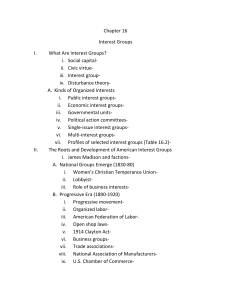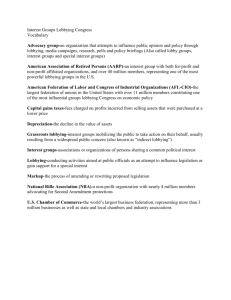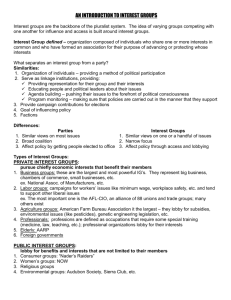Chapter 9: Interest Groups
advertisement

Chapter 9 Interest Groups Interest Groups Also sometimes known as factions, pressure groups, or special interests Has an organized membership and the pursuit of certain policy goals stem from the members’ shared interest Interest Groups Must want to influence policy to be called an interest group Political parties tend to address a broader range of issues According to OpenSecrets.org the top sectors and their total spending on influencing policy between 1998 and 2006 are: 1. 2. 3. 4. 5. 6. 7. 8. 9. 10. 11. 12. 13. Finance, Insurance & Real Estate $2,558,205,882 Health $2,298,865,053 Misc Business $2,257,719,539 Communications/Electronics $2,092,700,759 Energy & Natural Resources $1,670,116,451 Transportation $1,358,911,163 Other$1,252,273,819 Ideological/Single-Issue $848,747,426 Agribusiness $819,757,771 Defense$668,009,653 Labor$265,459,714 Construction$264,698,101 Lawyers & Lobbyists$188,142,079 Three Types of Interest Groups 1. 2. 3. Economic Citizens Government Economic Groups More economic groups exist because have more monetary resources People are encouraged to joining because of economic benefits (example: pay) Economic Groups Often people do not join for political reasons but so they may not support certain political figures Types of Economic Groups 1. 2. Business Groups: more than ½ of groups who lobby; virtually all large corporations and smaller businesses are a part (ex. Chamber of Commerce) Labor Groups: organized labor work largely on labor law but sometimes on trade, foreign policy, etc (ex. AFL-CIO) Types of Economic Groups 3. 4. Agricultural Groups: farm organizations (example: Association of Wheat Growers) Professional Groups: Most professions have lobbying groups (example: American Association of University Professors Citizens’ Groups Members drawn together by purposive incentives or opportunities to promote a cause in which they believe. Have a harder time acquiring resources than economic groups Citizens’ Groups Offer collective goods as incentives (example: clean water) Potential members might not join because they get some of the benefits even if they don’t Types of Citizen Groups 1. Public-Interest: claim to represent the broad interest of society as a whole (example: Common Cause) Types of Citizen Interest Groups 1. Single-Issue groups: organized to influence policy in just one area. (example: most environmental groups like the Sierra Club) Types of Citizen Groups 2. Ideological groups: have a broader agenda that comes from a philosophy or moral position (example: People for the Ethical Treatment of Animals, Christian Coalition) Government Interest Groups A growing group of interest represent governments that are both local, state and foreign States, cities, and other government units within the U.S. lobby (37 governors have offices in Washington, DC) Often try to include their views in the budgetary process Lobbying Federal statute defines lobbying as any communication made on behalf of a client to members of Congress, congressional staffers, the president, White House staff and high-level employees of nearly 200 agencies, regarding the formulation, modification, or adoption of legislation. Lobbying The Secretary of the US Senate and the Clerk of the US House of Representatives oversee federal lobbying. According to the Lobbying Disclosure Act of 1995, those offices are charged with providing guidance on lobbying disclosure, ensuring the timeliness and accuracy of required reports, and making those reports available to the public. Lobbying Inside lobbying refers to efforts to develop and maintain inside contacts with policymakers. Outside lobbying involves bringing the public pressure to bear on policymaking Lobbying Organizations that employ lobbyists in house must register with Congress if their lobbying expenditures exceed $24,500 during a six-month period. Lobbying firms must file a separate registration – at least 45 days after first contact – for each client whose lobbying billings exceed $6,000 for a six-month period. According to a Center for Public Integrity report, nearly 300 individuals and entities lobbied without filing proper registration forms. Ways Interest Groups Try to Influence Acquiring access (set meetings, dinners, etc) Developing relationships with congress and the executive branch (through meetings, dinners, phone calls, happy hours) Ways Interest Groups Try to Influence Providing information and legislation (most legislation often written by interest groups; congressional staffers reliant on good information) Filing lawsuits Ways Interest Groups Try to Influence Activating membership through grassroots pressure (grassroots initiatives) Donating Campaign funds (individual donations and Political Action Committees or PACs) Policies Policies derived from interest groups often benefit many interests and sometimes even the collective. If interest groups dictate policy, problems can occur. Provide a voice for like-minded people, especially in a two-party system.








